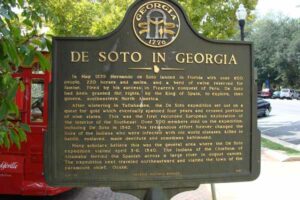Marker Text: In May 1539 Hernando de Soto landed in Florida with over 600 people, 220 horses and mules, and a herd of swine reserved for famine. Fired by his success in Pizarro's conquest of Peru, De Soto had been granted the rights, by the King of Spain, to explore, then govern, southeastern North America.
After wintering in Tallahassee, the De Soto expedition set out on a quest for gold which eventually spanned four years and crossed portions of nine states. This was the first recorded European exploration of the interior of the Southeast. Over 300 members died on the expedition, including De Soto in 1542. This tremendous effort forever changed the lives of the Indians who were infected with old world diseases, killed in battle, enslaved, made destitute and sometimes befriended.
Many scholars believe that this was the general area where the De Soto expedition visited April 3-8, 1540. The Indians of the Chiefdom of Altamaha ferried the Spanish across a large river in dougout canoes. The expedition next traveled northeastward and visited the town of the paramount chief, Ocute.

